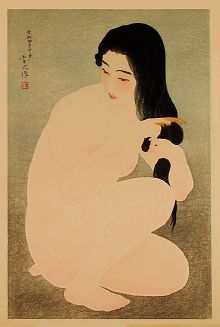In the early years of the 20th century, the burghers and entrepreneurs of the sleepy city of San Diego saw an opportunity to greatly expand their brand. The Panama Canal had opened in 1914, and they planned an international exposition in Balboa Park as a way to put the city’s seaport in the spotlight and bring what they hoped would be greatly expanded trade to the area. They also wanted to show the world San Diego’s cultural and artistic riches. The fair goers’ response to the pavilions boasting art and cultural exhibits was so enthusiastic that city leaders decided to remedy its lack of a major art museum to house the treasures on display at the fair. Thus, the idea for the San Diego Museum of Art was born. It opened in 1926.
In the last several decades, the museum’s holdings have been enriched by the donation of several noteworthy art collections, including a large group of English and French works; a collection of prints, posters, and paintings by French post-impressionist Henri de Toulouse-Lautrec; and one of Indian and South Asian art that includes more than 1,400 pieces. In 2009, a major collection of African, Oceanic, and Native-American artworks was transferred to the museum from the Sana Art Foundation, further expanding the museum’s international focus.
Several important exhibitions will be on display during the APA Annual Meeting in May that will make a visit to the museum in Balboa Park even more interesting for art lovers. One of the most interesting is titled “Arts of South and Southeast Asia” and surveys works encompassing nearly 2,000 years. Most of the earliest pieces are religious in theme and represent traditions of multiple religions including Hinduism, Buddhism, and Jainism. Later works give expression to the opening of trade routes that exposed people to new civilizations and to invasions and migrations across the vast region. By the late 1400s, European traders and missionaries found East Asia and along with their goods brought oil paintings and engravings.
Another exhibit focuses on the arts of a nation that has a rich artistic history. “Arts of Iran” reflects the development of the Persian nation and empire, which goes back at least 10 millennia to a time when Zoroastrianism was the chief religion. Since the seventh century, Islam has been the primary religion, and the art and artifacts shifted to reflect traditions and concept vital to this religion. Through paintings, ceramics, and calligraphy, the exhibit helps define the scope of Iran’s complex history through its artistic heritage.
Opening in April, and also highlighting the San Diego Museum of Art’s commitment to looking across the Pacific Ocean is an extensive exhibit titled “Modern Japan: Prints From the Taisho Era (1912-1926) and Beyond.” Most of the works are from the museum’s collection, but have not been on public display prior to this. Prints are the primary focus of the exhibit and are an excellent way to compare ancient and contemporary printing techniques.
The beautiful though precarious city of Venice, whose vistas have fascinated artists for centuries, is the subject of another special exhibit at the San Diego museum. “Venetian Views” features works by Venice’s homegrown masters such as Titian, Tintoretto, and Canaletto and those who were drawn to the city to try to capture its views and the unique light that illuminated these vistas. The latter group was known as vedutisti, or view-painters, and among their ranks were J.M.W. Turner and John Singer Sargent.
For museum goers looking for something far different from the usual experience will probably want to venture into “Visible Vaults,” which has recreated some of the “backstage” spaces that museum visitors rarely if ever get to see—the spaces in which the bulk of the collections are stored. Here are the pieces too fragile or light-sensitive to put on public display or that cannot be put in context in the museum’s galleries. The museum notes that in this project, “visitors will have the opportunity to discover nearly 300 little-known masterpieces, including works on paper, sculpture, ceramics, cloisonnȳ, snuff bottles, tiles, and paintings. They will be able to open drawers, peek into virtual storerooms, and take the time to sketch and observe some of the great treasures of the collection.” ■
More information on the San Diego Museum of Art can be accessed
here.



